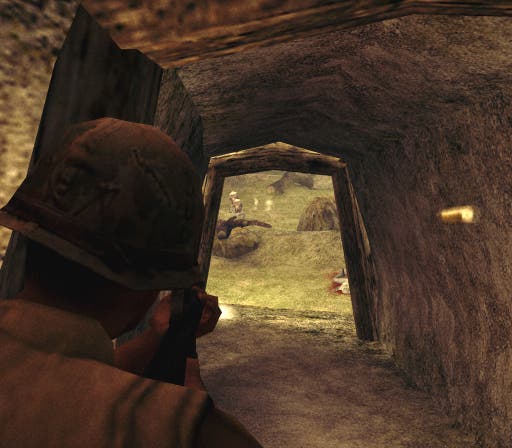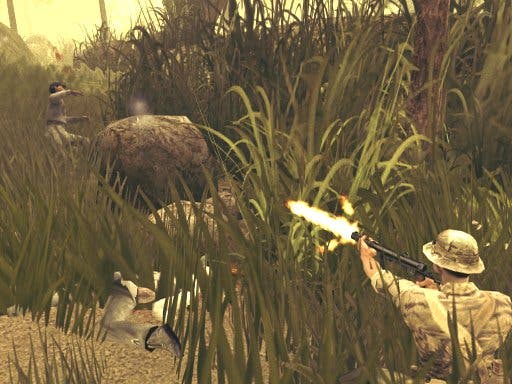Shellshock: Nam '67
Guerrilla pulls no punches with a brutal take on Vietnam...
Order yours now from Simply Games.
One of the first action sequences in Platoon chronicles Private Chris Taylor's first night in the bush. Oliver Stone shows his squad locking and loading and slides them into a mosquito hole with bulbous eyes and dripping skin. Taylor blames stinking heat and insects for his inability to sleep while the others watch. Claymores hang in the trees and the dark. And they all drift away in the end, soaked and exhausted. When Taylor wakes the rain is ceased and yellow mist drapes languidly over crystal moonlight, leaves and twigs and solid silence rolled with water drops. Then he sees the straw hats, the VC in the milky atmosphere, ghosts in the trees. Taylor hits a Claymore and begins one of film's most appalling, enthralling war scenes. Tracer in the jungle makes for horrific viewing. With the battle "won", the team desperately tries to revive the LMG gunner who's been shot in the gut, screaming at him, beating his chest, hissing at him to "take the pain". Medivac hovers, and he dies. Charlie Sheen's face in the final shot looks like child who's seen a ghost. Anyone who's seen Platoon will remember this scene for the atmosphere alone.
Because the atmosphere in Vietnam was severely rubbish, to be blunt. In the rubbish stakes, Vietnam was the world's biggest landfill, a hugely tragic, pointless war bred from paranoia and filled with blind insanity and pure horror. Truly great filmmakers like Oliver Stone, Francis Ford Coppola and Stanley Kubrick have all presented absolute classics on the Vietnam war, with films such as Platoon, Casualties of War, Full Metal Jacket and Apocalypse Now showing point blank the pure, terrifying waste and unending fear involved in the conflict in a notoriously unflinching manner.
Kill Kill Overkill

In recent times, game makers have tried to do the same. Following what has been nothing short of overkill (if you'll excuse the pun) in the WWII genre, the me-toos of shooterdom have, in the last 18 months, run headlong into providing their definitive take on the bloody Vietnam conflict. First we had Illusion Softworks' underrated Vietcong, Atari's fairly rubbish Line Of Sight, and now the 18-rated Shellshock: Nam '67, a game likely cause genuine offence. Parts of Shellshock will have Daily Mail readers' hair standing on end. Little Jimmy and his little friends had better be in bed before you whack this on.
Vietnam, for the Vietnam movies addict, is all about that chilling suspense and heavyweight action in the Platoon scene. Guerrilla (the team that worked on Shellshock is actually different from the Killzone unit - as seems obvious once you see the two games side by side) obviously realised this early on. The game could have gone either way. There's the "family friendly" EA-style route, a sanitised shooter of the like of Battlefield: Vietnam where people run around shooting each other in what is supposed to be a thrilling depiction of the war. Battlefield: Vietnam kind of ignores the side of the conflict that included rape, Agent Orange and huge American men gunning down farmers with M60s from Huey gun bays. The second route, obviously, is to bring on the crazy men wailing, "Come get some!" through a veil of lead; the kind that Illusion did so well with last year (and one that console owners will get to sample in a few weeks). Guess which one Shellshock picked?
From the off, Shellshock is like being kicked in the face with a size 10 Commie boot. What story is included involves a vicious Vietcong general given to massacre and not much else and your missions against his forces. It's shot in the third-person, has more death that a 15th Century plague party and lets you go as mental as you like with very big guns. You can shoot civilians, pigs (squeal little hog!), team-mates (although they always get up again, as seems to be the law in war-based games) and run around dungeons full of corpses in citadels with "welcome to hell" scrawled on the wall in the blood. It has heads on sticks, excreta-covered sticks flying out of trees into legs and sticks in pits. It has brutal suicide and in-your-face prostitution. It has swearing. It has a questionable control system and often does some fairly stupid things, but what it does very well is engender the Vietnam "atmosphere" you'd expect from a movie. Most importantly, it has mist in the jungle.
"Me so horny, GI!"

At first, the somewhat grainy graphical style appears out of kilter with the clean look of most current generation games. Like a sort of jungle-based Silent Hill, the gritty, misty look - far from being a cop out - actually allows Guerrilla more room to pack the levels with flora and fauna detail, and the dense, heavy environment often feels oppressive - more so with an array of excellent debris-laden explosive effects. We're not entirely sure or convinced whether this was deliberate or a happy accident, but the effect works for the most part, one way or another.
From one tense sequence to the next, everything about Shellshock evidently appears designed to jolt the player to the max. The atmosphere positively oozes from the game at times, with the unnervingly subtle jungle audio ambience wherever you go, but it's normally the precursor to some unseen horror. In one section you walk into a cave that you just happen to find when you're sneaking around. Inside the cave is a VC soldier surrounded by GIs willing him to put the gun down. In a cut-scene he screams his defiance of his US aggressors and shoots himself through the jaw in full view of the camera. Then the game switches back to real-time, you leave the cave and continue the mission. The only point is to unnerve you.
Later, once you've accumulated enough 'Chits' (the game's currency gained from picking up 'soldier stars' from the corpses of enemies, that, for once, don't simply vanish into the ether) you're allowed to have sex with Vietnamese prostitutes who tell you they're "so horny", the action taking place in huts, behind closed doors. And in the shooting itself - obviously the bulk of the game - the whole fear and run-and-gun aspect you'd hope would be included is on full display. Heads explode in a shower of gore, people scream in Vietnamese, civilians run for cover and beg not to be hurt. The film references are heavy; with most characters instantly recognisable to Vietnam popcorn addicts (you'll spot Bunny and Elias almost instantly). It's well constructed but harsh. It's really not nice. Like, really. It certainly forces you to pay attention.
But there are some places Eidos obviously wasn't comfortable going. Even though Shellshock carries an 18 certificate, the VC are always called "Charlie", as opposed to the "Gook" racial slur omnipresent in Vietnam films, and liberally used in Vietcong. Charlie is an equally racist terms as well, so we're not sure why this made it in but the other didn't. And there are no drugs (apart from a very cool late 60's soundtrack that positively reeks of narcotics). Why? It's inconsistent. How far is too far?
The Last Chopper Out

Other aspects of Shellshock rankle too. The controls and the use of a third-person perspective are chief among the questionable gameplay problems and design choices. For a game that plays like any other run-and-gun FPS, it's odd not to be able to switch to a more familiar and workable first-person mode. The constant need to wrestle with the targeting reticule to get your shots on target sullies the atmosphere, as does seeing your GI running around in backwards circles; quite why he's not allowed to jump is beyond us. This, along with a generally sluggish sense of movement and targeting frustrates, and conspires to dirty the ambience, but begins to pale into insignificance once it becomes all-too evident that Guerrilla endorses the laziest gameplay mechanic of them all; the endlessly respawning enemy.
Until you realise that the name of the game is to reach a set of arbitrary checkpoints, you can waste ages just killing dozens of respawning enemies (and run out of ammo as a result). Move forward a few paces and, presto, they stop their evil respawning ways. Why oh why, Mr games designer? What did we do to deserve such evil? Another strange decision was to implement a health system that really has no place in a war game - a kind of Halo-esque recharge system whereby your Terminator GI can take literally hundreds of bullets over the course of a level, but so long as you make sure you retreat behind cover, you'll always be able to survive any shots or explosions you take. Yes, that's right, including booby trap explosions, which in Shellshock you can survive every single time.
As if the basic mechanics weren't flawed enough, the enemy AI is also conspicuous by its absence. If the VCs aren't charging headlong in one continuous, mincing respawning parade of death, they're standing still awaiting their turn to be shot. Occasionally one might decide to duck down, but you never get the impression that they're remotely fearful for their lives, which bursts the atmospheric bubble entirely. On top of that, some of the levels are less than inspiring, most of them settling into a linear, predictable pattern of "kill everything, find the prisoner, blow up a boat" type scenarios. There are some noticeable exceptions, including a heavy weapons op in a Huey and the panic-stricken defence of a crumbling fortress that turns into a relentless galling bloodbath, but it's fair to say there could have been more invention in the missions. There's an awful lot of repetition to endure to get to the highlights.
Shell Out?
Where Shellshock succeeds is when it resolutely refuses to pull punches in its general content, and when it hits the spot it's briefly thrilling. But for those occasional flourishes it's simply weighed down by being an average shooter, albeit one that's boosted by contentious context and some well-realised attempts at atmosphere building. You might get occasionally frustrated with clunky controls and respawning enemy, but its saving grace is that it's never boring and, actually, the challenge towards the climax becomes severe. You begin to care for your character, and wince when his head disappears in a red mist.
At best, some of Shellshock's heavier action sequences and cut-scenes are truly memorable; sure, it's nowhere near movie standard - and like any war game is a trivial representation of a bloody conflict for our personal entertainment - but any game that can inspire that pit of the stomach feeling of the senselessness of it all is to be commended. Given that most games are all too happy to occupy that bland, sanitised landscape of kid safe sterility, the fact that Shellshock even bothers to try and venture into the murky raw realities of this sickening conflict mean we're more than happy to stick our thumbs up at Guerrilla's admirable ambition. Not too far, though. We don't want Private Taylor blowing them off.
Order yours now from Simply Games.







